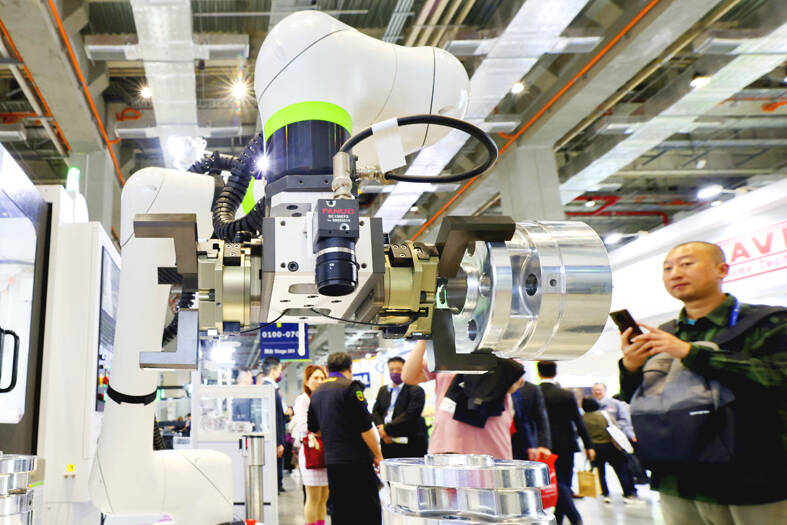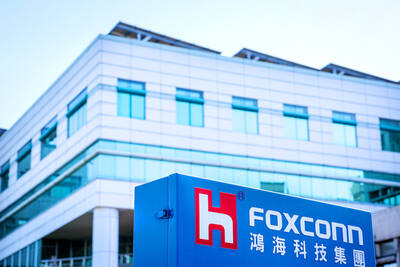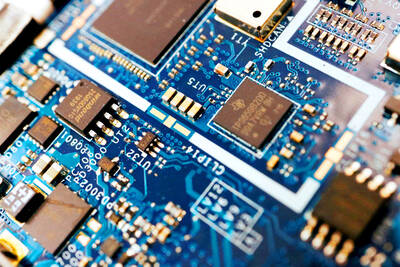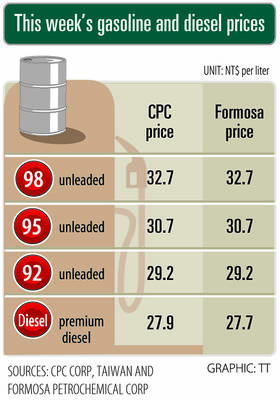Industrial production rose 6.01 percent year-on-year last quarter, snapping six quarters of losses, due to robust demand for artificial intelligence (AI) devices, high-performance computing (HPC) applications and data centers, the Ministry of Economic Affairs said yesterday.
Manufacturing output, which accounted for nearly 95 percent of industrial production, climbed 6.16 percent year-on-year in the first quarter, the first pickup since the second quarter of 2022, the ministry said.
The manufacturing surge was mainly driven by the semiconductor industry, which jumped 13.46 percent annually last quarter amid robust demand for AI chips, it said.

Photo: Ritchie B. Tongo, EPA-EFE
Industrial production also measures the change in the value of output produced by utilities and mines, the ministry said.
The ministry expects the growth momentum in industrial production to carry over into this quarter and forecast that manufacturing output would expand between 11.1 percent and 16.4 percent annually this month.
“We believe manufacturing production would improve every quarter for the remainder of this year, primarily backed by the semiconductor and electronic components segments. AI-related applications will continue to be the growth drivers,” Department of Statistics Deputy Director-General Huang Wei-jie (黃偉傑) said by telephone yesterday.
“However, the traditional sector is seeing a slow recovery, given lukewarm macroeconomic conditions. That could limit the growth of manufacturing output,” he said.
Asked about potential downside risks, Huang said the ministry would closely monitor geopolitical tensions, particularly in the Middle East, amid fears that conflict in the region could curb crude oil exports, leading to higher energy prices and undermine efforts by the US and other major economies to contain inflation.
“The return of high inflation would dampen consumer confidence. Consumers might balk at spending on new electronics again,” Huang said.
The production of electronic components, mainly semiconductors and displays, jumped 11.12 percent annually last quarter, thanks to strong demand for chips used in AI and HPC devices, the ministry said.
Chip designers, printed circuit board makers and DRAM suppliers also benefited from the AI boom, it said.
The production of computers and optical components increased 17.69 percent from a year ago, bolstered by higher demand for AI and cloud-based data centers, the ministry said.
Smartphone camera lenses demand also rose, thanks to specification upgrades.
The production of base metals, mostly steel, edged up 0.01 percent last quarter, ending 10 quarters of declines, but the recovery remained bumpy, given tepid demand and price competition, the ministry said.
Machinery output dropped 2.93 percent year-on-year last quarter as businesses were hesitant to invest in new equipment amid a slow global economic recovery, it said.
The production of automotive products rose 1.35 percent annually last quarter as increasing demand for electric vehicles offset weakness in sales of fossil fuel-powered cars and heavy trucks.
Petrochemicals saw production contract 3.28 percent year-on-year last quarter due to overcapacity and growing competition from overseas, the ministry said.

Hon Hai Precision Industry Co (鴻海精密) yesterday said that its research institute has launched its first advanced artificial intelligence (AI) large language model (LLM) using traditional Chinese, with technology assistance from Nvidia Corp. Hon Hai, also known as Foxconn Technology Group (富士康科技集團), said the LLM, FoxBrain, is expected to improve its data analysis capabilities for smart manufacturing, and electric vehicle and smart city development. An LLM is a type of AI trained on vast amounts of text data and uses deep learning techniques, particularly neural networks, to process and generate language. They are essential for building and improving AI-powered servers. Nvidia provided assistance

GREAT SUCCESS: Republican Senator Todd Young expressed surprise at Trump’s comments and said he expects the administration to keep the program running US lawmakers who helped secure billions of dollars in subsidies for domestic semiconductor manufacturing rejected US President Donald Trump’s call to revoke the 2022 CHIPS and Science Act, signaling that any repeal effort in the US Congress would fall short. US Senate Minority Leader Chuck Schumer, who negotiated the law, on Wednesday said that Trump’s demand would fail, while a top Republican proponent, US Senator Todd Young, expressed surprise at the president’s comments and said he expects the administration to keep the program running. The CHIPS Act is “essential for America leading the world in tech, leading the world in AI [artificial

DOMESTIC SUPPLY: The probe comes as Donald Trump has called for the repeal of the US$52.7 billion CHIPS and Science Act, which the US Congress passed in 2022 The Office of the US Trade Representative is to hold a hearing tomorrow into older Chinese-made “legacy” semiconductors that could heap more US tariffs on chips from China that power everyday goods from cars to washing machines to telecoms equipment. The probe, which began during former US president Joe Biden’s tenure in December last year, aims to protect US and other semiconductor producers from China’s massive state-driven buildup of domestic chip supply. A 50 percent US tariff on Chinese semiconductors began on Jan. 1. Legacy chips use older manufacturing processes introduced more than a decade ago and are often far simpler than

Gasoline and diesel prices this week are to decrease NT$0.5 and NT$1 per liter respectively as international crude prices continued to fall last week, CPC Corp, Taiwan (CPC, 台灣中油) and Formosa Petrochemical Corp (台塑石化) said yesterday. Effective today, gasoline prices at CPC and Formosa stations are to decrease to NT$29.2, NT$30.7 and NT$32.7 per liter for 92, 95 and 98-octane unleaded gasoline respectively, while premium diesel is to cost NT$27.9 per liter at CPC stations and NT$27.7 at Formosa pumps, the companies said in separate statements. Global crude oil prices dropped last week after the eight OPEC+ members said they would